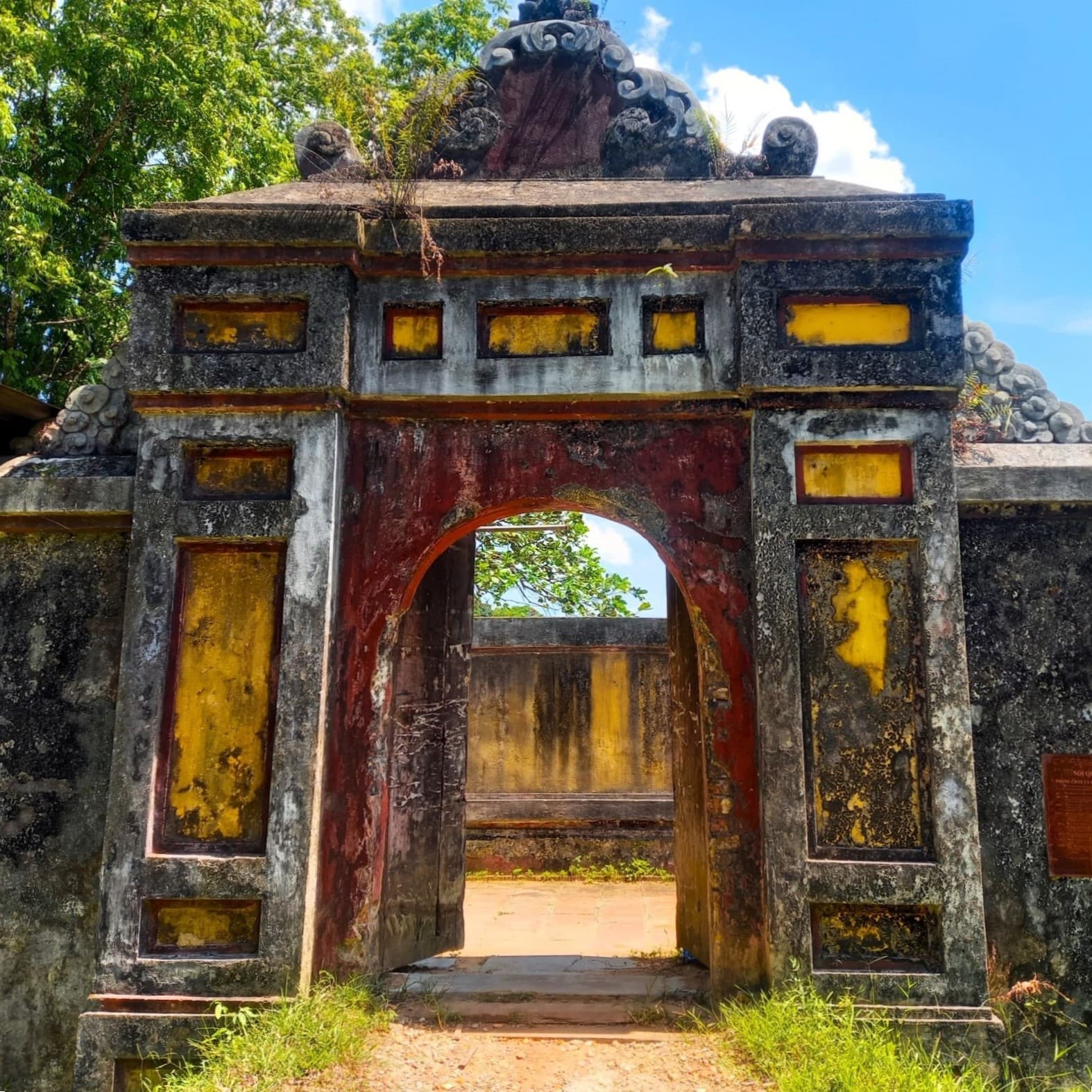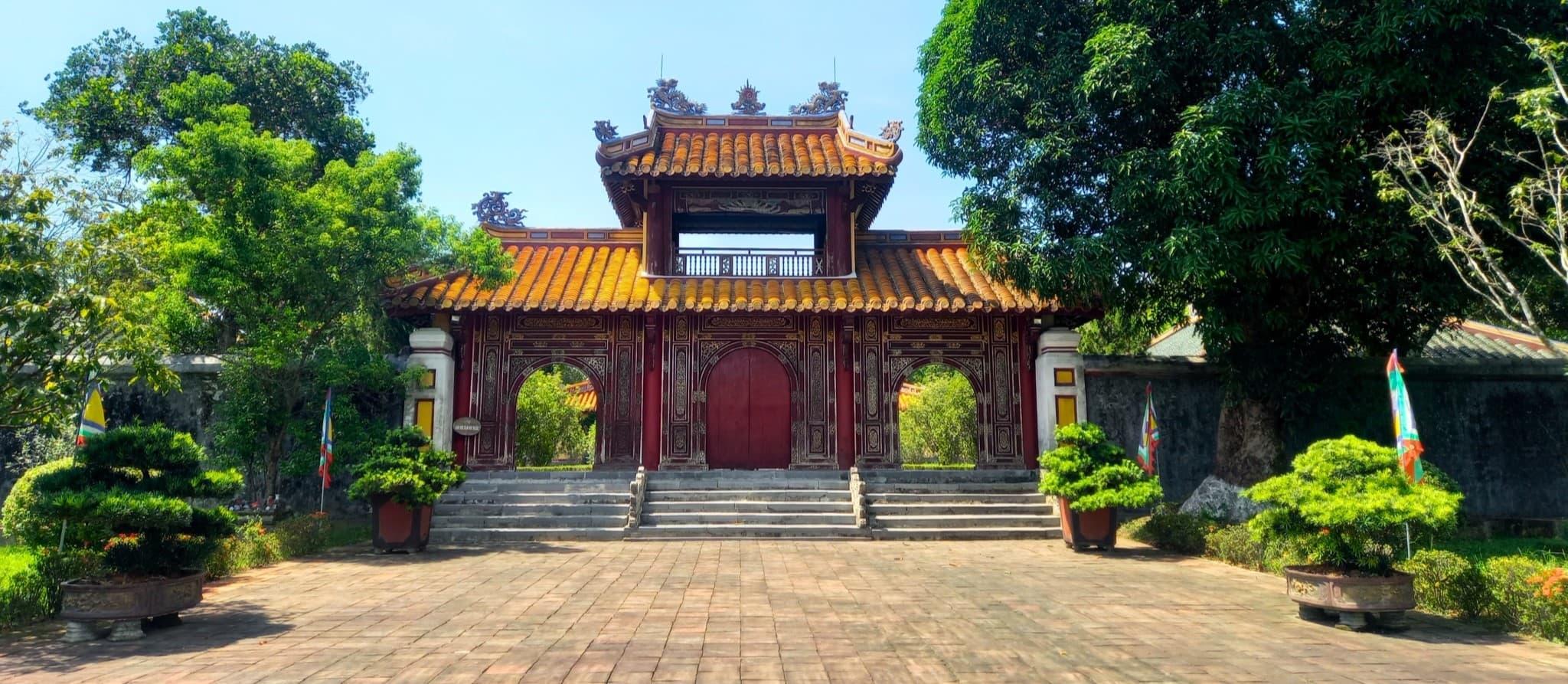First published October 2024 | Words and photos by Vietnam Coracle | 2 comments

Tom Divers is the founder and creator of Vietnam Coracle. He’s lived, travelled and worked in Vietnam since 2005. Born in London, he travelled from an early age, visiting over 40 countries (he first visited Vietnam in 1999). Now, whenever he has the opportunity to make a trip, he rarely looks beyond Vietnam’s borders and his trusty motorbike, Stavros. Read more about Tom on the About Page, Vietnam Times and ASE Podcast.
The first emperor of Vietnam’s last imperial line, Gia Long (1762-1820) was the founder of the Nguyễn Dynasty. A pivotal but much-maligned historical figure whose actions changed the course of Vietnamese history, Gia Long’s royal tomb stands in the peaceful countryside 20km south of Huế. Seldom visited and largely forgotten, this imperial mausoleum complex on the banks of the Perfume River was recently restored after years of neglect. Despite the historical significance of Emperor Gia Long, and the architectural and aesthetic appeal of his final resting place, his imperial tomb remains largely ignored by international and domestic travellers alike, especially compared to other Nguyễn Dynasty mausoleums surrounding Huế. Much like Phương Bối, a site associated with the one-time controversial but globally celebrated late Zen Buddhist monk, Thích Nhất Hạnh, I find it fascinating that a site connected with such an important historical figure as Emperor Gia Long should attract so little attention. Set in beautiful grounds, Gia Long’s tomb complex features temples, lakes, pillars, forests, hills and the royal sarcophagi of several imperial members. It’s a compelling site, but each time I’ve visited, between 2009-2024, I’ve been the only person there.

[Back Top]
TOMB OF THE FIRST EMPEROR
The Forgotten Mausoleum of a Pivotal Historical Figure
The Gia Long tomb complex is open daily between 7am-5.30pm. Tickets (adults: 150,000vnđ; children: free) can be purchased at the entrance. Some drinks and snacks are available near the entrance gate. The most atmospheric (and coolest) time of day to visit is the morning or late afternoon. However, if you visit during the middle of the day, you’re likely to have the entire complex to yourself. Bear in mind that the summer months (April-September) in Huế can be fiercely hot, whereas the winter months (October to March) can be surprisingly bitter and grey. You can combine a visit to Gia Long tomb with the many other Nguyễn Dynasty sites in the surrounding area. Click an item in the contents below for more information and, if you like this guide, please donate.

CONTENTS:

MAP:
Tomb Complex of Emperor Gia Long
Historical Background:
Before he became emperor in 1802, Gia Long was known as Nguyễn Ánh, a nephew in the line of Nguyễn Lords who ruled southern Vietnamese territories from the 16th century. In 1777, when he was just 15 years old, Nguyễn Ánh’s family were overthrown and killed by the Tây Sơn Rebellion, a movement which started in the central Vietnamese province of Bình Định and spread south and north, briefly occupying the entire country. Today, the revolt led by the Tây Sơn brothers is celebrated as a great military and political movement, seen as the precursor to the Communist revolution of the mid-20th century. Nguyễn Ánh fled, seeking refuge and help in many places, including the rival kingdom of Siam (Thailand) to the west and even the Chinese Qing Dynasty to the north. On the run for the best part of a decade, Nguyễn Ánh refused to accept defeat, working with whomever he could, and using whatever leverage he had, in order to build enough military and political strength to fight back against the Tây Sơn and re-establish control. In the late 1770s, he arrived on the island of Phú Quốc where he befriended French missionary and priest, Pigneau de Béhaine (1741-1799).
Nguyễn Ánh and the French catholic priest formed an alliance that would change the course of Vietnamese history, paving the way for the establishment of the Nguyễn Dynasty imperial line and, ultimately, the colonization of Vietnam by France. By 1787 Nguyễn Ánh had regained control of the southern regions and Béhaine travelled to France to the court of Louis XVI to sign the Treaty of Versailles, agreeing French military support for Nguyễn Ánh in exchange for economic and territorial concessions in Vietnam. But the political turmoil of the French Revolution in 1789 meant that the treaty was never implemented. However, Béhaine was still able to support his friend by providing a mercenary force, modern weaponry and tactics, which helped defeat the Tây Sơn Revolt by the turn of the century and establish Nguyễn Ánh as emperor in Huế, taking the royal title Gia Long in 1802. Béhaine passed away in 1799, and Nguyễn Ánh honored his friend with a royal–style tomb in Saigon, which stood for more than 180 years: the site is still known today as Lăng Cha Cả (The Father’s Tomb).
As emperor, Gia Long unified the country from south to north, ending centuries of civil war. He moved the capital from Hanoi in the north to Huế in the centre, established an imperial line that stood for the next 140 years, promoted Confucian values, improved Vietnam’s military capabilities to the extent that it became the strongest power in the region, and tolerated the spread of Catholicism via missionaries from abroad. The latter, which was a legacy of Béhaine’s assistance to the emperor, was not continued by his successors, and the subsequent persecution of Christians in Vietnam was ultimately used by the French as a pretext for invasion in the 1850s, as was the unimplemented Treaty of Versailles, which the French used as the basis on which to claim legitimacy for their colonial ambitions.
Despite his military and political victories, today Gia Long is seen as a weak leader who, by seeking foreign assistance to resolve domestic disputes, bears responsibility for putting Vietnam at the mercy of the French, whose colonial rule caused much suffering for the nation and lasted almost a century. As a result, of all the Nguyễn Dynasty imperial tombs surrounding Huế, Gia Long’s has long been the least visited and most neglected. Today, the mausoleum complex has finally been restored, but it remains largely deserted.

*Please Note: Historical information in this article is based only on my limited reading & understanding of various sources & conversations with people: I am not a historian & I cannot vouch for the accuracy of historical details in this article.




Emperor’s Mausoleum Complex:
[View Map]
As with all the imperial tombs in the countryside around Huế, the mausoleum complex of Emperor Gia Long was constructed according to the principles of phong thủy (feng shui). A form of geomancy that dictates where a structure should be built in relation to its surroundings in order to harness the power and energy of the natural elements, phong thủy often incorporates water, trees and hills, as well as considering natural phenomena such as the direction of the prevailing wind and the position of the sunrise and sunset. One of the desired effects is to create a balance between nature and architecture and, in the case of a tomb complex, a balance between death and life. The mausoleum represents mortality and the inevitability of death, but the grounds – full of plants, trees, flowers, birds and insects – represent the continuity of life.
Gia Long’s tomb complex sprawls over large grounds featuring several hills, lakes and forests. The structures include temples, shrines, pillars, bridges and gates, as well as the tomb itself. Although the complex is on a grand scale, it blends in with the natural environment: no structure is more than two storeys high and there are large green spaces between each building. This creates an appealing and somehow calming interplay of the natural and the man-made. It is the opposite effect of, for example, the Pyramids in Egypt, which takes an unnatural shape and constructs it on a colossal scale, so that even today it looks as if the pyramids have arrived in the desert from another planet. By contrast, the tomb complex of Gia Long seems to exist in harmony with its setting.
From the entrance, a lane leads south through fragrant pine trees towards the tomb complex. Constructed between 1814-1820, the tomb lies to the east of the lane, on and around Thiên Thọ hill. Originally built for Gia Long’s wife, Empress Thừa Thiên who died in 1814, today both empress and emperor lie side by side in a twin sarcophagus facing towards Thiên Thọ mountain. The emperor himself chose the location and oversaw construction. So involved was Gia Long that he stayed on the premises and was apparently almost killed one night when his shelter collapsed on him, badly injuring the emperor and others.

The tomb fronts a pretty lake full of lotus. At the foot of the tomb, a tiled area features stone statues of mandarins, elephants and horses – the emperor’s entourage. Several tiers of wide stairs flanked by stone dragons lead up to a bronze gate that goes through to the burial chamber, a stark and austere space with an altar in front of the sarcophagus. To the west of the tomb, Minh Thành temple is dedicated to the worship of the emperor and empress. An attractive building with tiled roof and painted wooden doors, the temple has recently been restored. On the hill on the opposite side of the lake stand two tall pillars. Resembling obelisks, these stand out as the only high structures in the otherwise low-rise complex. Indeed, these two are all that is left of dozens of pillars that originally stood around the perimeter of the mausoleum to serve as a reminder to passersby that they were in the presence of an emperor, and that their decorum should be suitably respectful.





Surrounding Tombs & Temples:
[View Map]
West of Gia Long’s tomb complex, a wooden bridge leads over the lotus lake to the opposite bank, around which are scattered the tombs of several other relatives of Gia Long. These include the emperor’s mother (1736-1811) at Thoại Thánh tomb, his elder sister (1759-1823) at Hoàng Cô tomb, and his second wife (1769-1846), mother of his successor Minh Mạng, at Thuận Thiên tomb. Gia Thành temple, on the north bank of the lake, is dedicated to the worship of the latter. Each of these tidy tombs resemble smaller versions of the emperor’s mausoleum. They are very rarely visited but well-maintained and peaceful. Taking the pathway circumnavigating the lake makes for a very pleasant walk and an opportunity to reflect on the historical legacy of the Nguyễn Dynasty, which began with Gia Long in 1802 and ended with Bảo Đại in 1945.





Getting There & Around:
[View Map]
The tomb of Emperor Gia Long is 20km due south of Huế. It takes about 20-30 minutes to reach by taxi, ride-hailing app (such as Grab or Xanh SM), or on a tour. However, if you are on a motorbike or a bicycle, a fun route option is to stay on the east bank of the Perfume River and cross it via a pontoon bridge (5,000vnđ; two-wheel vehicles & pedestrians only) and then follow the lane along the west bank of the river to the tomb entrance. It is also possible to reach the tomb by river from central Huế: ask and arrange through your accommodation or tour agency.
At the entrance to the Gia Long tomb complex, there are various modes of transportation to take visitors around the mausoleum. Bicycles, e-bikes and electric buggies are all available for fees ranging between 20,000vnđ-200,000vnđ depending on the vehicle and time period. In general, I would advocate walking around the complex, because the pathways are pleasant and the grounds are lush and pretty. However, it is large site so if the weather is very hot (or very wet), it might be a better idea to get a buggy or self-ride one of the bikes.




*Disclosure: I never receive payment for anything I write: my content is always free and independent. I’ve written this guide because I want to: I like this historic site and I want my readers to know about it. For more details, see my Disclosure & Disclaimer statements and my About Page





Really great post! I’ve been to some tombs of Nguyen emperors, including Khại Đinh’s, but not Gia Long’s. I was at the the site last winter in Hue where I saw some tombs + other stuff. went with mom, aunt, uncle, accompanied by Viet tour (being Viet American + knowing Viet)
Hi Andy,
Thanks and I hope you get a chance to visit Gia Long’s tomb next time you’re in the area!
Best,
Tom